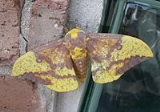
Eacles imperialis
Encyclopedia
The Imperial Moth is a Nearctic
member of the family Saturniidae
and subfamily Ceratocampinae
.
to Canada
and from the Rocky Mountains
to the Atlantic Coast. Nominate Eacles imperialis imperialis has been recorded historically from New England and Southern Canada, south to the Gulf Of Mexico and west across the Great Plains. In modern times, its range has receded northward (where it was always a good find); it is considered common south of the Mason-Dixon line. Subspecies E. imperialis pini occurs in coniferous and transition zone woodlands at the northern edges of the New England and Great Lakes States and northward into Canada. In the southwest, closely related Eacles oslari replaces imperialis, and thence southward into Mexico.
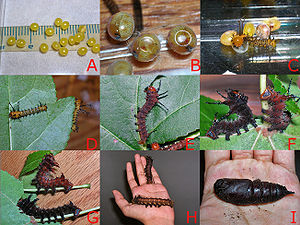
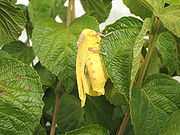 There is only one brood a year.
There is only one brood a year.
s and begins to molt. It first becomes dormant and undergoes apolysis
, then after an additional day or so, undergoes ecdysis
. The caterpillar emerges from its old exoskeleton, puffs up, and hardens as it enters the next instar. This species will sometimes eat the old exoskeleton for protein nutrition. Similar to many other Saturniidae caterpillars, the imperial moth has five instars. By the third instar, variation between caterpillars can be observed. This species is known to have two basic color forms, a black/orange form and a green/yellow form. There is also variation within those two forms on the head, spines, body, and feet. At the end of the 5th instar, the caterpillar will leave the tree and travel along the ground in search of a soft soil patch in which to pupate.
As with all of Saturniidae
, the adults do not feed. Their mouthparts have been reduced.

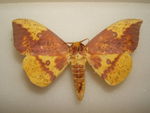 Sexual dimorphism is present in this species and all of Saturniidae
Sexual dimorphism is present in this species and all of Saturniidae
:-
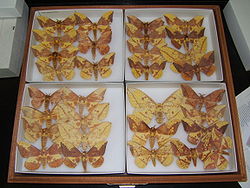 There is a high amount of variation within this species. The colors of the adult are always yellow and purple but can vary distinctly on this. Generally there is more purple on the forewing and more purple on males. However, one subspecies tends to have a distinct coating of purple over the entire wings.
There is a high amount of variation within this species. The colors of the adult are always yellow and purple but can vary distinctly on this. Generally there is more purple on the forewing and more purple on males. However, one subspecies tends to have a distinct coating of purple over the entire wings.
Darker, heavily mottled individuals are typical forms of the southern and western range and may represent a clinal variation of nominate imperialis. Subspecies pini to the north, and sibling species Eacles oslari to the southwest exhibit similar morphs. Regional foodplant preferences have been noted as well, although captive-bred populations from all sources are nearly omnivorous.
The Imperial Moth is perhaps the only example of such a creature as a character in a novel. Naturalist Gene Stratton Porter's "Girl Of The Limberlost" features imperialis prominently in the plot development, and her account of its life history in "Moths Of The Limberlost" (a chronicle of her discovery of lepidoptera in early 20th Century rural Indiana) captures not just the science but the charm of the giant silk moths and childhood discovery of nature.
Nearctic
The Nearctic is one of the eight terrestrial ecozones dividing the Earth's land surface.The Nearctic ecozone covers most of North America, including Greenland and the highlands of Mexico...
member of the family Saturniidae
Saturniidae
The Saturniidae, commonly known as saturniids, are among the largest and most spectacular of the moths. They form a family of Lepidoptera, with an estimated 1,300 to 1,500 described species worldwide...
and subfamily Ceratocampinae
Ceratocampinae
Ceratocampinae is a subfamily of the family Saturniidae.This subfamily contains the following genera:*Adelocephala Herrich-Schäffer, 1854*Adeloneivaia Travassos, 1940*Adelowalkeria Travassos, 1941*Almeidella Oiticica, 1946...
.
Range
Imperial moths (their many regional morphs, subspecies and sibling species) range from MexicoMexico
The United Mexican States , commonly known as Mexico , is a federal constitutional republic in North America. It is bordered on the north by the United States; on the south and west by the Pacific Ocean; on the southeast by Guatemala, Belize, and the Caribbean Sea; and on the east by the Gulf of...
to Canada
Canada
Canada is a North American country consisting of ten provinces and three territories. Located in the northern part of the continent, it extends from the Atlantic Ocean in the east to the Pacific Ocean in the west, and northward into the Arctic Ocean...
and from the Rocky Mountains
Rocky Mountains
The Rocky Mountains are a major mountain range in western North America. The Rocky Mountains stretch more than from the northernmost part of British Columbia, in western Canada, to New Mexico, in the southwestern United States...
to the Atlantic Coast. Nominate Eacles imperialis imperialis has been recorded historically from New England and Southern Canada, south to the Gulf Of Mexico and west across the Great Plains. In modern times, its range has receded northward (where it was always a good find); it is considered common south of the Mason-Dixon line. Subspecies E. imperialis pini occurs in coniferous and transition zone woodlands at the northern edges of the New England and Great Lakes States and northward into Canada. In the southwest, closely related Eacles oslari replaces imperialis, and thence southward into Mexico.
Status
Eacles imperialis is one of a few saturniid species in a regional decline throughout the northeastern US, with some New England states lacking records for many decades. A colony on Martha's Vineyard, Massachusetts has been the subject of scientific and local political activity, especially concerning preservation of sensitive frost-bottom oak/pine habitat. Reasons for decline are unclear, as is the true northern limits of nominate imperialis' range, due to possible confusion with subspecies pini in existing records. Imperialis is certainly a common species of middle-atlantic states, appalachia, the Ohio Valley and Deep South regions, and is associated with forest, rural and suburban habitat. It is possible that to the north, imperialis requires specific habitat and the increasing fragmentation of niches such as coastal or montane pine barrens is a factor.Life cycle


Larva
the caterpillars tend to wander before settling down to eat. The first instar generally lasts only a few days. At the end of each instar, a small amount of silk is spun on the major vein of a leaf. The caterpillar then latches onto the silk with its anal claspers and prolegProleg
A Proleg is the small fleshy, stub structure found on the ventral surface of the abdomen of most larval forms of insects of the order Lepidoptera, though they can also be found on other larval insects such as sawflies and a few types of flies....
s and begins to molt. It first becomes dormant and undergoes apolysis
Apolysis
Apolysis is the separation of the cuticula from the epidermis in arthropods and related groups . Since the cuticula of these animals is also the skeletal support of the body and is inelastic, it is shed during growth and a new covering of larger dimensions is formed. During this process, an...
, then after an additional day or so, undergoes ecdysis
Ecdysis
Ecdysis is the moulting of the cuticula in many invertebrates. This process of moulting is the defining feature of the clade Ecdysozoa, comprising the arthropods, nematodes, velvet worms, horsehair worms, rotifers, tardigrades and Cephalorhyncha...
. The caterpillar emerges from its old exoskeleton, puffs up, and hardens as it enters the next instar. This species will sometimes eat the old exoskeleton for protein nutrition. Similar to many other Saturniidae caterpillars, the imperial moth has five instars. By the third instar, variation between caterpillars can be observed. This species is known to have two basic color forms, a black/orange form and a green/yellow form. There is also variation within those two forms on the head, spines, body, and feet. At the end of the 5th instar, the caterpillar will leave the tree and travel along the ground in search of a soft soil patch in which to pupate.
Pupa
As with most of this subfamily, when the caterpillars are ready to pupate, they burrow underground.Adult
Adults emerge once a year to mate. In the northern part of their range they tend to emerge mid summer (June - August), while in the southern half they tend to emerge at more varied times (April - October). A linked pair is vulnerable to predators, particularly foraging raccoons.As with all of Saturniidae
Saturniidae
The Saturniidae, commonly known as saturniids, are among the largest and most spectacular of the moths. They form a family of Lepidoptera, with an estimated 1,300 to 1,500 described species worldwide...
, the adults do not feed. Their mouthparts have been reduced.
Sexual Dimorphism


Saturniidae
The Saturniidae, commonly known as saturniids, are among the largest and most spectacular of the moths. They form a family of Lepidoptera, with an estimated 1,300 to 1,500 described species worldwide...
:-
- The males are generally smaller and show larger patches of purple.
- The females are generally larger, mostly from carrying eggs, and are more yellow.
- The antennaAntenna (biology)Antennae in biology have historically been paired appendages used for sensing in arthropods. More recently, the term has also been applied to cilium structures present in most cell types of eukaryotes....
of the male is fibrous. - The females rear end is slightly bigger.
Food plants
Larvae feast on a variety of host plants including:- Quercus (OakOakAn oak is a tree or shrub in the genus Quercus , of which about 600 species exist. "Oak" may also appear in the names of species in related genera, notably Lithocarpus...
) - Acer (MapleMapleAcer is a genus of trees or shrubs commonly known as maple.Maples are variously classified in a family of their own, the Aceraceae, or together with the Hippocastanaceae included in the family Sapindaceae. Modern classifications, including the Angiosperm Phylogeny Group system, favour inclusion in...
) - Liquidambar styraciflua (American SweetgumAmerican SweetgumLiquidambar styraciflua, commonly called the American sweetgum, sweet-gum, alligator-wood, American-storax, bilsted, red-gum, satin-walnut, or star-leaved gum, is a deciduous tree in the genus Liquidambar native to warm temperate areas of eastern North America and tropical montane regions of Mexico...
) - Sassafras albidum (SassafrasSassafrasSassafras is a genus of three extant and one extinct species of deciduous trees in the family Lauraceae, native to eastern North America and eastern Asia.-Overview:...
) - Pinus (PinePinePines are trees in the genus Pinus ,in the family Pinaceae. They make up the monotypic subfamily Pinoideae. There are about 115 species of pine, although different authorities accept between 105 and 125 species.-Etymology:...
)
Other information

Darker, heavily mottled individuals are typical forms of the southern and western range and may represent a clinal variation of nominate imperialis. Subspecies pini to the north, and sibling species Eacles oslari to the southwest exhibit similar morphs. Regional foodplant preferences have been noted as well, although captive-bred populations from all sources are nearly omnivorous.
The Imperial Moth is perhaps the only example of such a creature as a character in a novel. Naturalist Gene Stratton Porter's "Girl Of The Limberlost" features imperialis prominently in the plot development, and her account of its life history in "Moths Of The Limberlost" (a chronicle of her discovery of lepidoptera in early 20th Century rural Indiana) captures not just the science but the charm of the giant silk moths and childhood discovery of nature.
External links
- Eacles imperialis, Butterflies and Moths of North America

